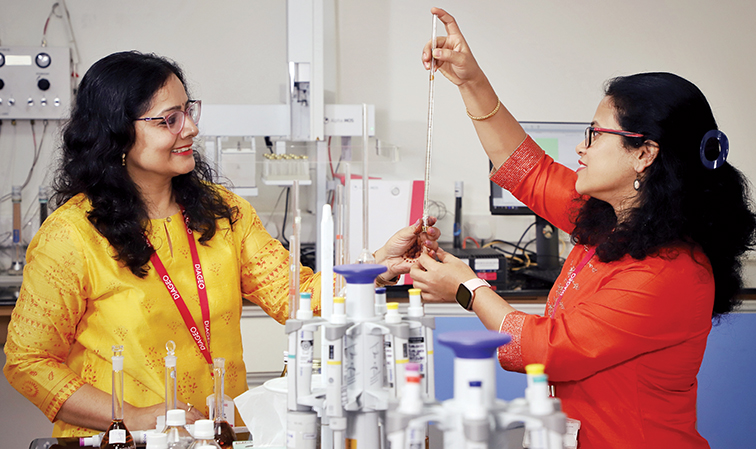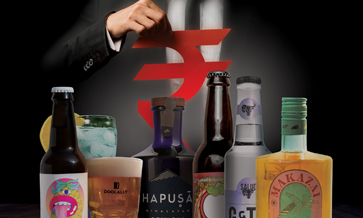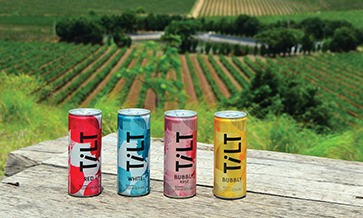Hina Nagarajan, Managing Director and CEO of Diageo India, speaks with Vikram Achanta on the current state of the alcobev industry, the challenges and opportunities that lie ahead, and how her company is gearing up to meet them
There have been exponential changes in the alcobev space in India. What does this mean to Diageo? What strategies are being adopted to keep up with the trends?
India is at an inflection point and the affluence is mind-boggling. The alcobev industry has been on a premiumisation journey. Looking at the future, we are looking at 100 million new legal drinking age (LDA) consumers in the next 5 years!
Our stated mission is to be the top-performing consumer packaged goods company in India. Our new strategy is built on three pillars. The first was a portfolio reshape. We divested 32 brands in the popular segment because that was not the future profit pool. We franchised 11 more and focused on premium and above. We also reshaped our value propositions for our remaining whiskey brands.
The second was building an organisation of the future. This was largely focused on upskilling people in the areas that we are going to need in the future: digital upskilling, as well as building capability across our technical functions. If you want to be a huge innovator, you need a lot of liquid capability.
The third was enhancing our role in society: the ‘Diageo and Society 2030 Goals’ we call them. There were three main areas in this: driving grain-to-glass sustainability, promoting positive drinking, and championing inclusion and diversity.
In your previous role, you looked after Africa and emerging markets, with 37 countries to steer. Could you compare and contrast any of these markets with the current stage of liquor market evolution in India?
I think a couple of things. One is the vibrancy of the economy and premiumisation, and the young economy. Africa is also like that and premiumisation was happening there.
The other one is tax and regulatory complexity. India is very complex; it’s like 36 countries rolled into one! Coincidentally, I was handling about 37 countries in Africa. Understanding their tax laws and the regulatory implications helped me kind of gear up for the advocacy that one needs to do here.
I’ll tell you how India is very different. One is that Africa is a much bigger beer market than a spirits market, and Guinness was the most loved brand. So, the spirits market was just beginning to evolve in those countries. I think the level of premiumisation and affluence in India is probably comparable to none.
And the third area is this 100 million LDA. That’s going to be 25% of the total global LDA coming in the next 5 years – that is way ahead of Africa! If I just look at the vibrancy of opportunity in India today, I don’t think there is another opportunity like that across the world!
What are the post-Covid trends you have noticed in India in terms of consumption? How have they impacted the alcobev industry in general and Diageo in particular?
There are four very critical ones. This was quite noticeable when we were working through our strategy and looking at consumer behaviour. The market was premiumising in any case even before the pandemic. But we saw an acceleration of premiumisation and the key driver of that was when people were confined to their homes, they sought high-quality brands. They wanted to drink better.
Moderation came from concern for health and well-being. And this accelerated the premiumisation in the market, which is now here to stay. The well-being phenomenon translated not only to better drinking but also to white spirits accelerating. Vodka seems to have got a new lease of life and suddenly growing double-digit.
There were two things here: one is this perception of vodka and the white spirits being better for health. The other was this whole experimentation and repertoire drinking that happened, as well as cocktail making. That gave an impetus to the whites.
Lastly sustainability: the pandemic has reframed attitudes for the whole world and consciousness of societal issues became much higher. As home drinking normalised, women have become more open and are experimenting. Going forward, women are a cohort that we see as quite important.

The tap of government-led institutional buying (canteen supplies for defence and police forces) has been turned off for bottled-in-origin brands. What is the remedy?
For us, our India strategy is about our global brands; but equally one of the biggest growth pillars for us is ‘Make in India for India and the world’. And our priority is getting all our beautiful Indian brands into CSD.
We also have our BIO Scotch brands – Black Dog, Black & White and Vat 69 – which are available there; and they are loved by these consumers. It doesn’t matter if two or three brands from our portfolio are not there. Let’s just get the rest of our portfolio and give the best choices to the consumer.
Moving to craft and innovation, you’ve got Epitome and Godavan off the ground. You’ve also set up your craft and innovation hub in Goa…
The whole idea of setting up our Ponda innovation hub (Goa), on which we have spent ?45 crore, was to accelerate our innovation and renovation journey, help with premiumisation and delve into the world of craft. Epitome and Godavan came out of that work because we felt that craft would be a big driver.
There is a huge appreciation of India and the artisanal craft spirits that are coming out of India. Our investment in Nao Spirits, with their Hapusa and Greater Than gins, was exactly for that purpose. The reason we invested in Nao Spirits is that the brands added the premiumisation aspect to our portfolio and they were scalable.
What’s your take on local spirits? Do you see any potential in any of them?
We are not yet seeing any of the local Indian craft spirits in a scalable manner. Feni and Mahua are very small and they are not scalable. I’m hoping that our innovation hub will be not only for our transformation but it is meant to support this start-up community and help the craft ecosystem in India. I’m hoping that we will find some breakthroughs at some point in time, but I don’t see them today.
Today we are talking about two categories. Who knows if there will be a third and a fourth category? Who would have thought that Indian single malts would grow faster than international malts? Godavan is now in Australia, New Zealand, the US and UAE, and we can compete with the best of the best there.
The liquid has won every single award and it is getting rave reviews. A few years ago, we wouldn’t have thought of that journey. That’s why I say never say no!
What particularly do you look out for in a company or brand that helps bring it into the consideration of Diageo or Distill Ventures?
The market is poised for huge growth and we continue to look for new growth engines: that’s a given. There are two to three things that we look for. The first is brilliant liquids. The second is scalability. And the third is complementing our premiumisation strategy.
It should have a fit in the portfolio. With Hapusa and Greater Than, the starting point was that they’re brilliant liquids. Hapusa is the only London dry gin in South Asia that is recognised by the Gin Guild and got its gold at the IWSC in 2021. Greater Than has great Indian provenance and great liquid. Gin is exploding, so it made eminent sense.
The most critical is the cultural fit of the founders’ thinking with Diageo or Distill Ventures. In Anand Virmani and his team (Nao Spirits), we found a lovely fit: compliance, similar principles of operating, a good vision, etc.
Global companies haven’t necessarily allocated enough stocks of premium liquids (aged Scotch, Tequila, etc.) to meet Indian demands. How is that changing?
India is recognised as one of the fastest-growing markets. The fact that I sit on the global executive committee speaks for that. I think a few years ago we recognised that we would need more capacity and we have invested in building substantive capacity for the rest of the world.
India is a top priority market for agave, as and when we are ready to explore it here. Going from a top market that is already growing very fast to now recognising that we are sitting in the decade of India, this can only get stronger. So, there is no constraint on Tequila: it will come as much as we want.
Coming to the India-UK FTA, how might it have an impact on your plans?
Firstly, we are very pleased it is on the agenda, and we are looking forward to it. It depends on the quantum of tax reduction and the timeline. It also depends on the reactions of various states to it.
The basic duty is a small part of the value chain; the states’ taxes are the ones that are large. The states have already reduced the duties for BiO. So, we have had a growth impetus there. I don’t think duty reductions will double the market, but it will give impetus to demand.
Our estimate is whether the duty goes from 100 or 50 over some time the drop in MRP could be 5% to 15% and we will have commensurate growth with that.
What are your perspectives on challenges and opportunities?
I think the challenges are very clear. Price regulation is one. The second is frequent route-to-market changes. The third is the complexity of the tax structure, which varies from state to state. In the short term, our focus is on profitability and this pricing focuses on productivity, driving efficiency through the value chain, and of course, advocacy.
We do advocacy all the time on price, even on route-to-market changes, to give us more outlets. Only 80,000 outlets for the alcobev sector versus 10 million for an FMCG: there is no comparison! Our advocacy continues to focus on trying to find a way to get a harmonised tax structure and an inflation index pricing mechanism.
If you just look at the positives of this market, we’re just discussing the demographics: about 175 million households in the upper or mid incomes by 2030 – that is more than many countries in the world!
AB InBev has lent its brand names to Budweiser Magnum whiskey and Seven Rivers spiced rum. How do you view a trend like this?
Particularly for India, I welcome competition. Because we have one of the lowest per capita consumption in the world and very low market penetration. I think investment by different companies only brings better choices, and investment brings category expansion.
It is forcing us to get even better on our innovation and renovation. It is making the consumer more demanding; and it gives huge impetus to our agenda to do better. That said, we have not seen too many beer companies succeed in the spirits area.
You have initiatives like the Diageo Bar Academy and the Diageo World Class. Two of the top three winners this year were women: Aashie Bhatnagar and Siya Negi. What would your message be to the Indian bartending community?
We have trained 8,000-odd bartenders and bar owners through the Diageo Bar Academy. The World Class platform is so stupendous for showcasing Indian talent and inclusion-diversity narrative. My message is use these platforms: become part of them, and use them generously because there is so much knowledge there. Along with building bartending skills, focus on consumer-customer relationships as well.
What about your personal drinks preferences?
Tanqueray 0.0 with Tonic is my favourite drink. Godavan has been added to my repertoire now: I’m an absolute fan of Godavan!
Where is your favourite place to have a drink?
You’re going to laugh at this: my sofa at home! I travel so much Vikram, that nothing gives me more pleasure than curling up on my sofa. For me, the big indulgence is being at home. I love doing that!













